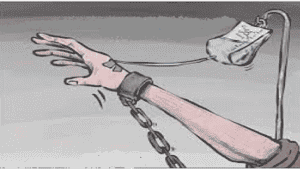by Jason Tarnow | May 5, 2020 | Crime, Legal Rights, Media, Police, Social Media, Wheels Of Justice
On April 18 and 19 2020, Gabriel Wortman was solely responsible for the largest mass shooting in Canadian history, which claimed the lives of 22 innocent people including veteran RCMP Cst. Heidi Stevenson. Wortman, a 51 year old denturist, went on a rampage in Portapique, Nova Scotia using firearms that police suspect were obtained illegally, likely from the United States. Eventually he was cornered at a gas station and died in a shootout with police.
Just shy of two weeks later, Prime Minister Justin Trudeau announced a ban on approximately 1,500 different models of military grade assault-style weapons. The announcement came as a surprise to no one – back in 2015, the Liberal government campaigned on promises to address gun violence. In addition to banning assault-style weapons, the Liberal government vowed to implement a buy-back program for prohibited firearms, establish red-flag legislation, impose tighter restrictions for proper storage of firearms and licensing, and to grant municipalities the power to ban handguns.
Trudeau’s announcement has sparked outrage among gun owners and enthusiasts, although overall most Canadians are in favour of stricter regulations regarding firearm ownership.

It’s important to understand what the ban actually applies to. It prohibits the sale, transport, import and use of semi-automatic weapons – Ruger Mini-14, M14 semi-automatic, Beretta CX4 Storm, and CSA-VZ-58 to name a few. Fully automatic weapons are already banned in Canada. Semi-automatic firearms were previously classified as either restricted or non-restricted, and will now be classified as prohibited.
So what do you do if you already have these in your possession? That depends.
Due to their classification as prohibited weapons, effected firearms will essentially become useless. In any event, gun owners will not be forced to relinquish them – but they will be provided with an incentive to do so. Though unclear at this point, the Canadian Government will be implementing a “buy back” program for all applicable firearms – aka, you’ll be paid to turn them over. For gun owners wishing to retain their firearms, there will be an option to be “grandfathered” into ownership. Certain terms and restrictions will apply, and will likely turn these weapons into collector’s items.
Unlike in the United States, our Charter does not include a constitutional right to bear arms

For those who choose to do nothing and simply retain their weapons, the consequences could be severe. Being found in possession of a prohibited firearm comes with the potential of spending years behind bars and a criminal record that could negatively impact employment and traveling prospects for life. The Canadian Government has instituted an amnesty period (waiting period) to allow for gun owners to consider their options. In any event, all gun owners must be in compliance, one way or another, by April 2022.
Though there is definitely a tight-knit community of lawful and responsible gun owners in Canada, the point of the ban is to limit access of tactical weapons among Canadians. Unlike in the United States, our Charter does not include a constitutional right to bear arms – so you can be sure that tighter regulations are on the horizon.
by Jason Tarnow | Apr 29, 2020 | Crime, Criminal Attorney, Legal Aid, Legal Rights, Media, Police, Politics, Social Media, Uncategorized, Wheels Of Justice
High on the list of things that have changed due to COVID-19 is our perception of what truly qualifies as an essential service – the transportation of goods by freight haulers, grocery stores and pharmacies, waste management and sanitation, and the list goes on. Service providers in these sectors are now being recognized for their significant contributions to our communities. In recent weeks, safety measures have been formulated and established, such as the installation of acrylic screens to act as a barrier between cashiers and customers, temporarily suspending the use of cash, and constantly monitoring supply stocks and evaluating the best methods to ensure that protective personal equipment is available to those working in healthcare.
But what about the justice system?
On March 18, 2020, court operations were abruptly suspended in BC. Mass adjournments of almost all trials, for those detained and those awaiting trial free in the community, has created uncertainty for accused persons and for their counsel. It has also highlighted systemic flaws that have been dismissed for far too long.

The Court of Appeal of BC was the first to announce that, beginning May 4, 2020, appeals (all appeals, not just those deemed urgent) would be heard using the platform “Zoom”. A notice from the Chief Justice of British Columbia elaborated further and noted that the courts would use Zoom only until the government supplied a “permanent, enterprise videoconferencing solution”, lending likelihood to the idea that some of the interventions relied upon during the COVID-19 pandemic could become permanent adaptations.
COVID-19 emphasized the court systems’ vulnerability to interruption. At some point along the line, preference to proceed with business as usual was prioritized over adjusting to function optimally in a society that is increasingly reliant on digital mechanisms.
Currently, much of the paperwork involved in criminal proceedings is processed manually by court services staff (with the exception of some electronic documents) at the registry. Rules for fax filing vary by registry, which often creates confusion for counsel.
Here are some examples of what modernization could look like:
|
Change
|
Effect
|
| Online court schedule for all levels of court |
Counsel can manage their court schedule with more flexibility and can coordinate appearances in various jurisdictions with other counsel to maximize efficiency |
| Video-conferencing from correctional facilities to the office of counsel and to the court |
Clients have more personal interactions with their counsel. Visits to the correctional centre can be limited (not replaced completely). If those in custody can appear exclusively by video, it reduces the number of inmates being transported via vehicle, saving time, money, and sheriffs’ resources |
| Enhanced online filing for court documents |
Fewer issues with errors relating to form. Court services staff spend less time on data entry manual processing. |
| Digital court files |
Court services staff can access all materials in one system and forward materials as needed to judicial staff. Storage of materials digitally saves an enormous amount of space. Archived files can be easily obtained rather than being stored “offsite”. Enhanced security for all files. Counsel could access court documents, such as a Record of Proceedings, online instead of having to make requests to court services staff |
| Digital disclosure transfer |
All disclosure would be digitized, allowing law enforcement, crown counsel, court staff, and defence counsel to exchange documents without delay. Significant reduction in paper usage and courier/postage costs. |
While other sectors prioritize adopting innovation, the court system has all-but ignored important opportunities for tech reform. Budgetary limitations are a frequent excuse. And of course, cost is an important factor – but it should not override value. The technology exists and has the potential to be extremely advantageous in the courtroom, and is often utilized more frequently in more remote jurisdictions such as Prince George, BC and throughout the Yukon Territory. Due to the logistical difficulties associated with residing in a remote location, video-conferencing is often used at trial for out-of-town witnesses.
Before the era of social distancing and COVID-19, there seemed little reason to forge ahead towards modernization with any sense of urgency – the old adage “if it ain’t broke, don’t fix it” comes to mind – but now, we simply don’t have a choice.
by Jason Tarnow | Apr 21, 2020 | Crime, Criminal Attorney, Legal Aid, Legal Rights, Media, Politics, Uncategorized, Wheels Of Justice
It has been over one month since the Courts of British Columbia significantly curtailed operations in an attempt to combat COVID-19.

For many of those who work in the legal field, it was this development that made it all real. It quickly became clear that the novel coronavirus had the potential to spread quickly, and the confined space of a courtroom serves as ideal grounds for transmission.
Despite the coronavirus acting as a proverbial wrench in the gears of justice, the judicial system continues to putter along. This is largely due to increased utilization of technological tools like video/conferencing for court appearances and swearing of affidavits, and relaxing restrictions when it comes to fax/electronic filing of court documents.
Video conferencing isn’t new to the BC court system. As early as 2002, Judges across the province agreed that the technology improved procedural efficiency by facilitating witness testimony from distant locations and allowing interim appearances by video involving counsel from other jurisdictions. Judges also noted the value of video- conferencing for inmates at correctional centres – defeating the purpose of transferring multiple inmates from various correctional centres to various courthouses. The bottom line is that modernizing certain aspects of the criminal justice system makes sense financially and systemically – and events like COVID-19 demonstrate how it can have occupational benefits too.
At present, there is enormous value in modernizing certain judicial processes for two reasons – one, to limit face-to-face interactions between judicial staff, defence counsel and an Accused person, and two, to mitigate the consequences of what can only be described as colossal delay.
In reducing operations, the majority of criminal trials scheduled between March 18, 2020 and June 1, 2020, have been adjourned generally to dates in June and July, 2020. Cases that are deemed to be of an urgent nature will be able to proceed, although in a procedural sense, things will look different – for example, witnesses who would ordinarily appear before the Court to give evidence may be authorized to testify via video. For the most part, however, trials will proceed at a date that is likely much later than originally anticipated.

The situation is more grim for accused persons in custody awaiting their trial. Inmates are, of course, among the most vulnerable to contracting the novl coronavirus – a concern that was a topic of discussion before the courts closed – but didn’t really become part of the actual narrative until it was too late Trials for accused persons in custody have also been adjourned (for trials scheduled between March 23 and May 16, 2020). Sentencing hearings and bail hearings for accused persons will proceed. This could be positive – for some, it might result in their immediate release from the correctional system. For others, further incarceration for as little as an additional 90 days in custody will be devastating, a potential death sentence.
It is far too early to gauge how overwhelmed the court system will be at the return to business as usual – but when you consider that there was a huge backlog before COVID-19 shut it all down, it seems only reasonable that extreme measures – such as implementing night/weekend court, and permanently authorizing certain modernization measures – will need to be taken to truly return to normal.
by Jason Tarnow | Sep 23, 2019 | Crime, Criminal Attorney, Legal Aid, Legal Rights, Police, Wheels Of Justice
Bill C-75 received Royal Assent on June 21, 2019. The Act amends the Criminal Code, the Youth Criminal Justice Act (“YCJA”), the Victim Surcharge Bill (C-28), the Exploitation and Trafficking in Persons Bill (Bill C-38), and the Unconstitutional provisions Bill (Bill C-39).

Lacking a comprehensive amendment since 1972, the bail provisions of the Criminal Code have been revised to address concerns that have been mounting for several decades. The Act seeks to simplify the judicial interim release process by expanding the conditions on which the police can release an Accused person, thereby making an appearance before a Justice unnecessary. The Act will also seek to reduce judicial delay by ensuring that release conditions are not redundant, unrealistic or overly complex, and that sureties are not overburdened.
If successful, the amendments relating to bail will result in fewer Administration of Justice Offences (“AOJO”) being brought before the Canadian courts. In any event, the Act has laid new framework by which these offences will be dealt with. Offences of this nature are offences that are “committed against the integrity of the justice system”, including but not limited to: failing to comply with bail conditions (no contact, no-go, abstinence alcohol/drugs to name a few), failure to appear in court, and breach of probation. Amendments to the Act provide that these offences will be directed to a judicial referral hearing when appropriate, as opposed to immediately laying a breach charge. At a judicial referring hearing, rather than focus on the guilt or innocence of the accused, the Judge will review the conditions imposed, and will decide how to proceed. Judicial referral hearings will not appear on a person’s criminal record – however, if a person does not appear for their hearing, the investigating police officer may use their discretion to either drop or proceed with the charge. Since Administration of Justice Offences account for about 4 out of every 10 incidents reported by police, removing these matters from the traditional court process will likely have a substantial impact on managing judicial delay.
The Act amends several portions of the YCJA. Firstly, it limits the conditions that can be placed on a young person upon their release from custody, in hopes of avoiding breaches that occur only due to unnecessarily rigid conditions. The intended result will be lower frequencies of Administration of Justice Offences. Additionally, prosecutors will no longer be obligated to consider an adult sentence for youth charged with serious violent offences, and are no longer obligated to bring that decision to the attention of the Court. The Crown will also not be obligated to consider an adult sentence for a youth convicted of a serious, violent offence.
In the interests of addressing delay, the Act has also removed certain elements of the judicial process, many of which could likely hinder an Accused person’s ability to make full answer and defence to the charges against them. Firstly, the Act restricts the availability of Preliminary Inquiries to offences that carry a maximum punishment of 14 years or more in prison (previously, any indictable offence could attract a Preliminary Hearing). Preliminary Hearings are an excellent opportunity for the Crown, Defence and Judge to assess the strength of the prosecution’s case. It assists with judicial case management, providing insight into the length of time required for witnesses to give their evidence, issues requiring a Voir Dire, and the number of days required for trial. In certain instances, it may also provide an opportunity for the defence to consider a resolution proposal, in circumstances where the evidence presented guides such a decision. Additionally, the Act permits Judges to limit the issues explored during a Prelim, and which witnesses may be called. It goes without saying that indictable matters aside from first degree murder and aggravated sexual assault are deserving of a Preliminary Hearing.
The Act also modifies the procedure for jury selection. Peremptory challenges, which allowed counsel to reject a potential juror without requiring a reason, have been abolished. There were serious concerns surrounding the misuse of peremptory challenges to ensure the jury was of a particular composition – one that would be adverse to the interests of the Accused.
The objective of the Act, broadly, is to reduce judicial delay by targeting and eliminating systemic flaws that impede the wheels of justice from turning as they should – but constitutional challenges are still to be expected.
If you’ve been charged with a criminal offence, it is crucial that you contact an experienced criminal lawyer without delay. We are conveniently located in Richmond, B.C., only a few steps away from Brighouse Station on the Canada Line, which brings you from various locations in Metro Vancouver in 20 minutes. We service all areas of the lower mainland (including but not limited to Surrey, New Westminster, Port Coquitlam, North Vancouver, and Abbotsford) the interior of B.C. (including but not limited to Cranbrook, Kelowna, Kamloops, and Salmon Arm), Northern B.C. (including but not limited to Prince George, Prince Rupert, and Quesnel) and in the Yukon Territory where we offer services in Whitehorse, Dawson City, Faro, Mayo, and Old Crow. Contact our office today to speak to a criminal defence lawyer without delay.
by Jason Tarnow | Jul 19, 2018 | Crime, Legal Rights, Media, Social Media, Uncategorized
In early July, the BCSPCA announced charges against Mr. Hopcraft under the Prevention of Cruelty to Animals Act and the Veterinarians Act after viewing a video posted on Mr. Hopcraft’s “Wild Education” Facebook page showing him relieving a blood python of a bowel obstruction.
Contrary to what the BCSPCA has alleged, this procedure did not cause the python any harm, pain, nor discomfort. In fact, the python was relieved of a 6-month build up of excrement in its bowel track, which was surely causing it incredible discomfort.
Today, the python is alive and well, as confirmed by its happy owners.
While Mr. Hopcraft takes these charges very seriously, we take the position that this is nothing more than the BCSPCA’s attempt to, once again, slander Mr. Hopcraft in the Court of Public Opinion and try to put him out of business.
As many of you know, Mr. Hopcraft has considerable knowledge and more than 18-years experience in handling and caring for exotic animals. For years, Mr. Hopcraft has been educating the general public on television, in your children’s schools, and at your community events. Over these years, Mr. Hopcraft has consistently demonstrated that his primary objective is to ensure the well-being of his animals, many of which come to him as neglected or abandoned pets.
Furthermore, since the BCSPCA publicly announced charges against Mr. Hopcraft, numerous veterinarians in British Columbia have reached out and denounced the BCSPCA’s allegations towards him. Their consensus is that the python suffered no harm, and that if the python were to be sedated in any way (which the BCSPCA suggested ought to have happened) that the python could have experienced complications and/or died.
Mr. Hopcraft will meet these charges in a court of law and until his trial date he is to be presumed innocent.
Finally, Mr. Hopcraft, and his Wild Education organization, will proudly continue to care for its animals and he looks forward to continuing to educate you all about them.
Jason Tarnow
Legal Counsel to Michael Hopcraft
by Jason Tarnow | Apr 10, 2018 | Crime, Criminal Attorney, Legal Rights, Police, Wheels Of Justice
 On March 29, 2018, Bill C-75 had its first reading in the House of Commons, and upon publication, was quick to receive scrutiny from lawyers across the country.
On March 29, 2018, Bill C-75 had its first reading in the House of Commons, and upon publication, was quick to receive scrutiny from lawyers across the country.
The Bill seeks to amend provisions of several key pieces of legislation, including the Criminal Code and the Youth Criminal Justice Act. However, in doing so, many rights currently afforded to an Accused will become a thing of the past.
The first major concern that stands out is the proposal to abolish the use of peremptory challenges in the jury selection process. When jurors are being selected, an Accused person and his Defence counsel are afforded 12 of these challenges, permitting them to deny a juror without explanation. Crown Counsel also has 12 challenges for their own use. The purpose of peremptory challenges is to provide balance in the adversarial trial process – however, the motivation behind their use differs depending on who you ask. The Bill doesn’t elaborate on how jury selection will be managed without peremptory challenges.
Equally alarming is the proposal to deny Preliminary Hearings for offences that don’t carry a maximum term of life imprisonment upon conviction. It is also being suggested that Justices be given power to limit issues examined and witnesses called during a Prelim. The Preliminary Hearing’s purpose is to determine whether the Crown has enough evidence to commit an Accused person to stand Trial, a valuable tool for the Defence in any given case (even if the offence doesn’t carry a potential life sentence). However, it isn’t beneficial only to the Accused. The evidence heard at a Preliminary Hearing is transcribed, to be recalled upon by parties at Trial. The issues explored at the Prelim can assist in narrowing what issues will be raised at trial, which in return reduces the likelihood of wasted court time on irrelevant issues (especially important in consideration of the impact of delay!). With the ability to seek a Direct Indictment from the Attorney General, the proposal to limit Prelims is wholly unnecessary.
Next up, and not surprisingly, we see this Bill seek to increase punitive measures for Accused persons facing allegations of abuse against an intimate partner. These consequences begin prior to any finding of guilt – in fact, they begin at the onset of proceedings, when an Accused person seeks release on bail. Bill C-75 suggests more “onerous interim release requirements” for individuals facing allegations relating to violence against an intimate partner. This essentially means that the terms of release will be increasingly stringent. On that note, the Bill also proposes to increase the maximum term of imprisonment for repeat intimate abuse offenders, and to have violence against a partner considered an aggravating factor at
sentencing.

Perhaps most disturbing is the revision relating to police powers and written evidence in the form of an Affidavit. Currently, a police officer is required to attend a trial in person to give oral evidence regarding their involvement in the case. They are subjected to cross-examination on that involvement, at which time they must truthfully answer questions posed by the Defence. This is a crucial opportunity for the Defence to raise reasonable doubt (when considering that police officers often offer the most compelling and credible evidence) which is the only reason for taking a matter to trial. Of course, the Defence will still be allowed to apply to cross-examine a police officer on their written evidence – but that application requires additional court time, and one struggles to believe that such an application would be denied in any event. So this proposed amendment will likely result in additional delay and squandered court time.
Many of these amendments strike at the heart of the adversarial process, and an Accused’s person’s right to make full answer and Defence to the charges against them. Numerous changes are procedural, justified by the assertion that too many cases are being thrown out over judicial delay. Systemic flaws, a lack of inquiry and input by judicial staff, and failure to accept and validate the concerns of concerned legal professionals in the private sector are a few of the factors that have resulted in impractical proposals pushed forward in Bill C-75.







 On March 29, 2018,
On March 29, 2018, 